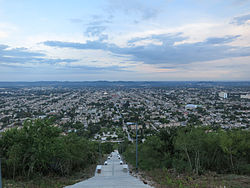Holguín
| Holguín | ||
|---|---|---|
| City | ||
 |
||
|
||
 Holguín municipality (red) within Holguín Province (yellow) and Cuba |
||
| Location of Holguín in Cuba | ||
| Coordinates: 20°53′19″N 76°15′26″W / 20.88861°N 76.25722°WCoordinates: 20°53′19″N 76°15′26″W / 20.88861°N 76.25722°W | ||
| Country | ||
| Province | Holguín | |
| Established | 1523[1] | |
| Area[2] | ||
| • Total | 655.9 km2 (253.2 sq mi) | |
| Elevation | 5 m (16 ft) | |
| Population (2011)[3] | ||
| • Total | 346,191 | |
| • Density | 528/km2 (1,370/sq mi) | |
| Demonym(s) | Holguinero,-a | |
| Time zone | EST (UTC-5) | |
| Area code(s) | +53 24 | |
| Vehicle registration | O | |
| Website | Official website | |
Holguín (Spanish pronunciation: [olˈɣin]) is a municipality and city in Cuba, and the capital of Province of Holguín. It also includes a tourist area, offering beach resorts in the outskirts of the region. After Havana, Santiago de Cuba, and Camaguey, it is the fourth largest city in Cuba.
Contents
History[edit]
It was founded as San Isidoro de Holguín in 1545,[4] and it is named after its founder Captain García Holguín, a Spanish military officer. Prior to 1976, Holguín was located in the province of Oriente. In Pope Francis' visit to the United States, in September 2015, he visited Cuba before the U.S., and while in Cuba, he visited the Diocese of Holguin to, among other things, commemorate the location where Christopher Columbus landed.
Geography[edit]
The municipality is divided into the barrios of Aguarás, Aguas Claras, Alcalá, Arroyo Blanco del Sur, Báguanos, Cabezuelas, Cacocún, Calderón, Camazán, Cauto del Cristo, Corralillo, Cruces de Purnio, Damián, Floro Pérez,Gibara, Guabasiabo, Guayabal, Guirabo, Haticos del Purial, La Aguada, La Cuaba, La Palma, La Rioja, Las Calabazas, Managuaco, Melones, Norte, Omaja, Purnio, San Agustín, San Andrés, San Francisco, San Juan, San Lorenzo, Santa Rita, Sur, Tacámara, Tasajeras, Uñas, Uñitas, Velasco, Yareyal and Yayal.[1]
Infrastructure[edit]
There are several small city parks such as Parque Infantil, Parque San Jose, Parque San Isidoro, Parque Marti among others, most central the Calixto García in the downtown area. Close by one finds the galleries Centro Provincial de Arte and Bayado, a library, the club Casa de la Trova, the Martí cinema, the Theatre Eddy Suñol, the Province Museum La Periquera, a science museum, and a history museum. From the hill Loma de la Cruz, where a large crucifix is installed, which can be ascended by its 450 stairs, one can oversee the whole city.
Holguín has a baseball stadium. The Frank País International Airport (city code HOG) is connected to Havana and several other world destinations.
Education[edit]
The main secondary education institution is the University of Holguín.
Economy[edit]
The brewery Cerveceria Bucanero - a joint venture with Labatt of Canada - is based in the city. It makes three brands of beer (Bucanero, Cristal and Mayabe) sold in convertible pesos.
Near Holguín, the Villa El Quinque and the Villa El Cocal receive patients like Argentine soccer star Diego Maradona who was treated for his cocaine addiction there. The popular Playa Pesquero resort (Fishing Beach) is located on the coast north of Holguín city, about an hour's drive from the International Airport.
Demographics[edit]
In 2004, the municipality of Holguín had a population of 326,740.[3] With a total area of 666 km2 (257 sq mi),[2] it has a population density of 490.6/km2 (1,271/sq mi).
Transportation[edit]
Holguín is served by Frank País Airport (HOG/MUHG), located at 20°47´08"N, 076°18´54"W.
Notable residents[edit]
- Manny Vazquez, Cuban artist and writer.
- Faustino Oramas, Cuban composer and musician
- Mario Kindelán, Olympic Gold Medalist amateur boxer
- Eglise Gutiérrez, opera singer
- Reinaldo Arenas, poet and novelist
- Oscar Hijuelos, Cuban-American Pulitzer Prize-winning author, whose parents were born and raised in Holguín before immigrating to the USA.[5]
- Puntillita (Manuel Licea), Cuban popular singer
- Delfin Pratts, poet
- Aroldis Chapman, Major League Baseball player
Sister cities[edit]
 Etobicoke, Ontario, Canada
Etobicoke, Ontario, Canada Santa Fe, New Mexico, United States[6]
Santa Fe, New Mexico, United States[6] Saltillo, Coahuila, Mexico
Saltillo, Coahuila, Mexico Allahabad, Uttar Pradesh, India
Allahabad, Uttar Pradesh, India Yazd, Yazd, Iran
Yazd, Yazd, Iran
References[edit]
- ^ a b Guije.com. "Holguín" (in Spanish). Retrieved 2007-10-05.
- ^ a b Statoids. "Municipios of Cuba". Retrieved 2007-10-05.
- ^ a b Atenas.cu (2004). "2004 Population trends, by Province and Municipality" (in Spanish). Archived from the original on 2007-09-27. Retrieved 2007-10-05.
- ^ Guije.com (September 2004). "Ciudad de Holguin". Retrieved 2007-02-17.
- ^ Hijuelos, Oscar, Thoughts Without Cigarettes: A Memoir, 2011.
- ^ "Interactive City Directory". Sister Cities International. Retrieved 12 March 2014.
External links[edit]
| Wikimedia Commons has media related to Holguín. |
- (Spanish) Holguín Web portal
- English-language city guide
- Holguin beaches guide
- Holguin Cuba (English) (French)
- Cuba Holguin
- Holguin (German)
- Casa particular website - English city guide and photos



